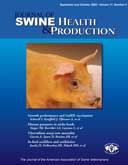Abstract:

Growth performance and carcass traits of boars raised in Germany and either surgically castrated or vaccinated against gonadotropin-releasing hormone
Friedrich Schmoll, Dr med vet habil; Johannes Kauffold, Dr med vet habil; Andre Pfützner, DVM; Johannes Baumgartner, Dr med vet; Fiona Brock, MSc; Mario Grodzycki, Dr med vet; Stuart Andrews, MSc, PhD
Complete article is available online.
PDF version is available online.
Objectives: To test the effect on male growth performance and carcass traits in a typical German production operation comparing vaccination against gonadotropin-releasing hormone (GnRH) with surgical castration early in life to control boar taint.
Material and methods: Boars were either surgically castrated within the first week of life (G1; n = 91), vaccinated against GnRH (Improvac; Pfizer Animal Health, Louvain-la-Neuve, Belgium) twice at 10 and 21 weeks of age (G2; n = 89), or not treated (G3; n = 12). Animals were slaughtered at 25 to 26 weeks of age. Growth performance (overall daily weight gain; G1 and G2) and carcass traits (% lean muscle, loin muscle, and backfat thickness; G1 and G2) were recorded, and intensity of boar taint was organoleptically assessed (G2 and G3).
Results: Boar taint was observed in intact boars (G3) but not in vaccinated boars (G2) at slaughter 4 to 5 weeks after the second vaccination. The carcasses of G2 boars were significantly leaner and had less backfat than those of surgical castrates (G1). There was a tendency of G2 boars to have greater weight gain than G1 pigs during growing-finishing.
Implications: Vaccination of boars against GnRH, as performed in this study, reliably controls boar taint and yields superior carcass traits when compared with surgical castration.
Keywords: boar, castration, gonadotropin-releasing hormone vaccination, Improvac
![]() Cite as: Schmoll F, Kauffold J, Pfutzner A, et al. Growth performance and carcass traits of boars raised in Germany and either surgically castrated or vaccinated against gonadotropin-releasing hormone. J Swine Health Prod 2009;17(5):250-255.
Cite as: Schmoll F, Kauffold J, Pfutzner A, et al. Growth performance and carcass traits of boars raised in Germany and either surgically castrated or vaccinated against gonadotropin-releasing hormone. J Swine Health Prod 2009;17(5):250-255.
Search the AASV web site for pages with similar keywords.
